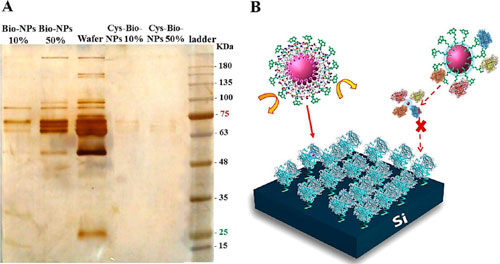| Posted: Sep 01, 2016 | |
Zwitterionic nanoparticle coatings to bypass the protein corona problem |
|
| (Nanowerk Spotlight) One of the major goals in nanomedicine is to make targeted nanoparticles for effective imaging and delivery applications. To that end, various surface functionalization strategies are employed to target nanoparticles to specific organs, cells, or organelles. | |
| During recent years, however, it was found that the protein corona can change the biological identity of nanoparticles and cover the targeting species at their surfaces and thus cause mistargeting. | |
| When nanoparticles enter the human body, for instance as part of a nanomedicine application, they come into immediate contact with a collection of biomolecules, such as proteins, that are characteristic of that environment, e.g. blood. Subsequently, a biomolecular layer – mainly composed of proteins – will cover the nanoparticle surface and change its 'synthetic identity'. This protein layer can hinder interactions between the targeting ligands at the surface of nanoparticles and their binding partners on the cells' surface. | |
| The layers of proteins adsorbed to the surface of a nanomaterial at any given time is known as the protein corona (see our previous Nanowerk Spotlight: "Biological responses to nanoparticles are temperature-dependant"). | |
| Following extensive research in the field of bionano-interfaces, it is now well understood that the primary interaction of biological species – such as cells – with nanoparticles is strongly dependent on this long-lived protein corona. The amount, composition, and exposure site of the associated proteins in the protein corona can define the biological response to the nanoparticles and hence reveal their biological fate (see our previous Nanowerk Spotlight: "Plasmonic heating can change the biological fate of nanoparticles"). | |
| To overcome the effect of an accumulated protein corona on the targeting capability of nanoparticles, one approach is the design of antifouling surface coatings. To that end, one of the most employed coatings is non charged poly (ethylene glycols) (PEG), which exhibits good resistance against nonspecific adsorption. | |
| The temperature dependent swelling of PEG coatings, however, can permit nonspecific adsorption of proteins. Furthermore, particularly during biological conditions, adsorption of some plasma proteins (e.g., fibrinogen, IgG, and apolipoprotein E) have been reported even with PEG-coated surfaces. | |
| Very recently, the use of zwitterionic coatings has emerged as an alternative strategy to provide corona free nanoparticles. | |
| "It is known that zwitterionic ligands can inhibit the protein corona formation," says Morteza Mahmoudi, Director of and Principal Investigator at the NanoBio Interactions Laboratory at Tehran University of Medical Sciences. "Therefore, the main hypothesis of our current work was to use both zwitterionic- and targeting-ligands at the surface of nanoparticles to reduce the shielding effects of protein corona." | |
| "Interesting behavior of zwitterionic materials has motivated us to start this study with designing biotin-cysteine conjugated silica nanoparticles – biotin was employed as a targeting molecule and cysteine was used as a zwitterionic ligand – to inhibit corona-induced mistargeting and two targeting platforms," he continues. "The first platform is a modified silicon wafer substrates with streptavidin (i.e., biotin receptor) to simulate a target, and the second platform is a cell-based model platform using tumor cell lines that overexpress biotin receptors." | |
| The researchers found that the targeting efficacy of nanoparticles with zwitterionic coatings was significantly higher than the same nanoparticles without zwitterionic coating. | |
 |
|
| (A) SDS-PAGE gels for washed samples (two times with PBS), Bio-NPs (10-50%), and Cys-Bio-NPs (10-50%) and protein adsorbed on the surface of modified wafer in 50% plasma after two times washing with PBS. (B) Schematic representation of successful targeting of Cys-Bio-NPs and failure Bio-NPs binding to streptavidin modified substrate. (reprinted with permission by American Chemical Society) (click on image to enlarge) | |
| "All obtained results clarify that the utilization of zwitterionic surface accompanying target molecule can alter the story of protein corona formation in a good direction," Mahmoudi points out. | |
| The team's results, published in the August 15, 2016 online edition of ACS Applied Materials & Interfaces ("Bypassing Protein Corona Issue on Active Targeting: Zwitterionic Coatings Dictate Specific Interactions of Targeting Moieties and Cell Receptors"), demonstrate that this approach can substantially enhance targeting yield of nanoparticles and thus provide promising new types of nanocarriers for high yield biological applications. | |
| Potential applications of this work are the fabrication of various new types of nanocarriers for high-yield targeted imaging and delivery applications. | |
| Going forward, the team plans to probe pharmacokinetics and targeting efficacy of the particles in in vivo conditions. | |
| As demonstrated by this work, zwitteration of nanoparticles as an important alternative of PEGylation could receive extensive attention in biological applications. However, extensive experimental and computational evaluations will need to be performed to shed more light on the mechanism behind adsorption resistance of zwitterionic coating, which today is poorly understood. | |
 By
Michael
Berger
– Michael is author of three books by the Royal Society of Chemistry:
Nano-Society: Pushing the Boundaries of Technology,
Nanotechnology: The Future is Tiny, and
Nanoengineering: The Skills and Tools Making Technology Invisible
Copyright ©
Nanowerk LLC
By
Michael
Berger
– Michael is author of three books by the Royal Society of Chemistry:
Nano-Society: Pushing the Boundaries of Technology,
Nanotechnology: The Future is Tiny, and
Nanoengineering: The Skills and Tools Making Technology Invisible
Copyright ©
Nanowerk LLC
|
|
|
Become a Spotlight guest author! Join our large and growing group of guest contributors. Have you just published a scientific paper or have other exciting developments to share with the nanotechnology community? Here is how to publish on nanowerk.com. |
|
